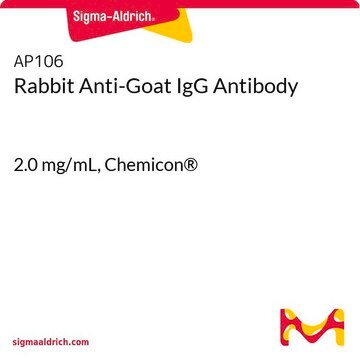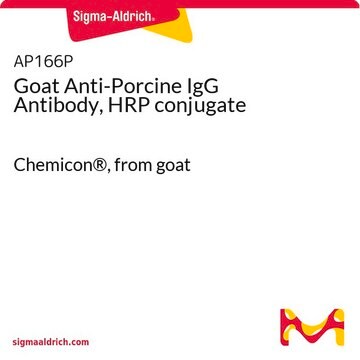AP107P
Rabbit Anti-Goat IgG Antibody, Fc, HRP conjugate
1.0 mg/mL, Chemicon®
Sign Into View Organizational & Contract Pricing
All Photos(1)
About This Item
UNSPSC Code:
12352203
eCl@ss:
32160702
NACRES:
NA.46
Recommended Products
biological source
rabbit
Quality Level
conjugate
peroxidase conjugate
antibody form
F(ab′)2 fragment of affinity isolated antibody
antibody product type
secondary antibodies
clone
polyclonal
species reactivity
goat
manufacturer/tradename
Chemicon®
concentration
1.0 mg/mL
technique(s)
ELISA: suitable
western blot: suitable
shipped in
wet ice
target post-translational modification
unmodified
Related Categories
Specificity
Based on immunoelectrophoresis, the antibody reacts with the heavy chains on goat IgG but not with the light chains on most goat immunoglobulins. No antibody was detected against goat IgM, or against immunoglobulin serum proteins, but antibodies may cross-react with immunoglobulins from other species.
Application
ELISA and Western Blotting 1:5,000 - 1:100,000
Immunohistochemistry 1:500 - 1:5,000
Optimal working dilutions must be determined by the end user.
Immunohistochemistry 1:500 - 1:5,000
Optimal working dilutions must be determined by the end user.
Rabbit anti-Goat IgG Antibody, Fc, HRP conjugate is an antibody against Goat IgG for use in ELISA & WB.
Research Category
Secondary & Control Antibodies
Secondary & Control Antibodies
Research Sub Category
Fragment Specific Secondary Antibodies
Fragment Specific Secondary Antibodies
Physical form
Lyophilized. Buffer = 0.01 M Sodium Phosphate, 0.25 M NaCl, pH 7.6, with 15mg/mL BSA and 0.01% Thimerosal.
RECONSTITUTION:
Reconstitute with sterile distilled water to match the volume indicated on the label. Centrifuge product if it is not completely clear after standing for 1-2 hours at room temperature.
RECONSTITUTION:
Reconstitute with sterile distilled water to match the volume indicated on the label. Centrifuge product if it is not completely clear after standing for 1-2 hours at room temperature.
Storage and Stability
Maintain lyophilized product at 2-8°C for up to 12 months. After reconstitution the product is stable for several weeks at 2-8°C as an undiluted liquid. After dilution do not use for more than one day. For extended storage after reconstitution, add an equal volume of glycerol to make a final concentration of 50% glycerol followed by storage at -20°C in undiluted aliquots for up to 12 months. Please note the concentration of protein (and buffer salts) will decrease to one-half of the original after the addition of glycerol. Avoid repeated freeze/thaw cycles.
WARNING:
Use of sodium azide as a preservative will substantially inhibit the enzyme activity of HRP.
WARNING:
Use of sodium azide as a preservative will substantially inhibit the enzyme activity of HRP.
Legal Information
CHEMICON is a registered trademark of Merck KGaA, Darmstadt, Germany
Disclaimer
Unless otherwise stated in our catalog or other company documentation accompanying the product(s), our products are intended for research use only and are not to be used for any other purpose, which includes but is not limited to, unauthorized commercial uses, in vitro diagnostic uses, ex vivo or in vivo therapeutic uses or any type of consumption or application to humans or animals.
Not finding the right product?
Try our Product Selector Tool.
Storage Class Code
11 - Combustible Solids
WGK
WGK 3
Certificates of Analysis (COA)
Search for Certificates of Analysis (COA) by entering the products Lot/Batch Number. Lot and Batch Numbers can be found on a product’s label following the words ‘Lot’ or ‘Batch’.
Already Own This Product?
Find documentation for the products that you have recently purchased in the Document Library.
Sanghoon Han et al.
Cancer research and treatment : official journal of Korean Cancer Association, 48(3), 1141-1153 (2015-12-24)
One of the features in cancer development is the migration of cancer cells to form metastatic lesions. CYR61 protein promotes migration and the epithelial-mesenchymal transition in several cancer cell types. Evidence suggests that CYR61 and dexamethasone are relevant to colorectal
Yutaka Yamamuro et al.
Experimental animals, 68(1), 49-56 (2018-08-14)
A relationship between coat color and behavioral characteristics has been reported for numerous species. We previously indicated that particular behavioral traits contributing to the genotype at the agouti locus manifest only when possessing a wild-type allele at the albino (i.e.
Gang Wu et al.
Wellcome open research, 6, 134-134 (2022-03-01)
Background: Siglec-1 is a macrophage lectin-like receptor that mediates sialic acid-dependent cellular interactions. Its upregulation on macrophages in autoimmune disease was shown previously to promote inflammation through suppressing the expansion of regulatory T cells (Tregs). Here we investigate the molecular
Guangyin Yu et al.
Experimental and therapeutic medicine, 19(1), 205-213 (2019-12-20)
Estrogen-related receptor γ (ERRγ) is a member of a small group of orphan nuclear receptor transcription factors that have been implicated in several physiological and pathological processes, including placental development, regulation of metabolic genes or disease. The pattern of expression
Mélanie Morin-Brureau et al.
The Journal of neuroscience : the official journal of the Society for Neuroscience, 31(29), 10677-10688 (2011-07-22)
Recent studies suggest that blood-brain barrier (BBB) permeability contributes to epileptogenesis in symptomatic epilepsies. We have previously described angiogenesis, aberrant vascularization, and BBB alteration in drug-refractory temporal lobe epilepsy. Here, we investigated the role of vascular endothelial growth factor (VEGF)
Our team of scientists has experience in all areas of research including Life Science, Material Science, Chemical Synthesis, Chromatography, Analytical and many others.
Contact Technical Service








